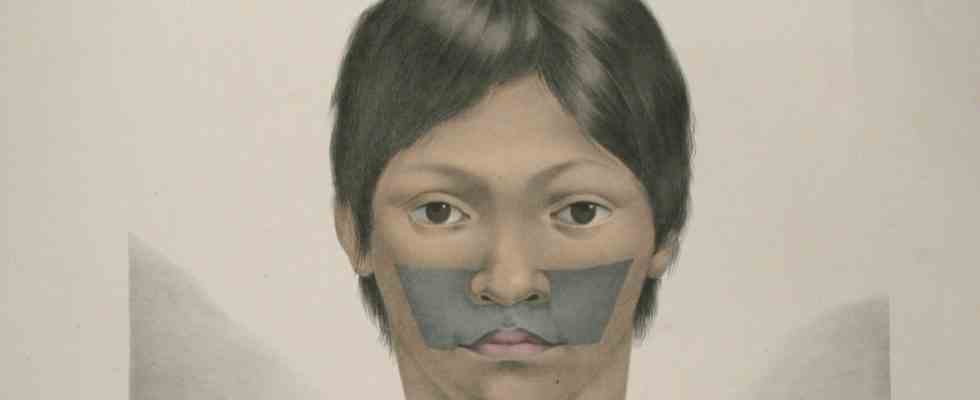At first they called the boy with the lost look Iuri. Iuri, like the Amazonian people he came from. The ten-year-old child costs two axes from the local slave traders. The physician and botanist Karl von Martius and the zoologist Johann Baptist von Spix take the boy with the trapezoidal tattoo on the upper lip and cheeks home to Munich in 1820, from their Brazil expedition, to which they went on behalf of King Max I Joseph of Bavaria in February 1817 left. And a twelve-year-old girl from the Miranha they also shop at the same time. Two “Native American” children, it is said, for “research purposes”.
The two are baptized in Brazil, Bavarian Catholic with the names Johann Iuri and Isabella. Two bought and abused souls who, as soon as they arrive at the Isar, are shown around like exotic animals. “Munich Kindl” against my will. The archive and library of the Archdiocese of Munich and Freising have now titled their current online exhibition with the supposedly homely term (www.erzbistum-muenchen.de/archiv-und-bibliothek). Roland Götz, deputy director of the facility, calls it a deliberately “poisoned title”.
Baptism, marriage and death registers were the only registers of civil status until 1876
It’s about, says Götz, “what written traces people have left in Munich who don’t fit the cliché of the ‘Münchner Kindl’.” The main source for the biographies of the 17th to 19th centuries, which are disclosed, served the scientists “parish registers”, mostly from Munich’s inner city parishes. These baptism, marriage and death registers were the only civil status registers in Bavaria until the introduction of the state registry offices in 1876.
Here you can also find “Morgan”, which the Wittelsbach Duke Maximilian in Bavaria, father of the later Empress Elisabeth “Sisi” of Austria, bought with his companions on the slave market in Cairo in 1838 during their joint journey to the Orient – alongside four other “Mohren” in the Age between twelve and 16 years. They had previously been kidnapped from their sub-Saharan homeland by Arab slave traders when they were children. The tobacconist on the Nile demanded 37 thalers, 750 piasters to be precise, for Morgan.
Exhibited like trophies, the African boys are baptized in the cathedral
The yellow-tinged parish registers also contain fragments of the boy’s origin: “Morgan; … he is probably a Nubian, about 12 years old.” The Munich nobles probably didn’t want to know that exactly anyway: From March 30, 1839, “Morgan” was called Alexander. On the most prominent baptism date that the Catholic Church has to offer, Holy Saturday, the five young people are properly exhibited and formally made Christians in the cathedral “morning between 8:30 and 9:30”.
Anyone who wants can delve more or less deeply into the historical files in the virtual exhibition, which are classified and illustrated, depending on their thirst for knowledge. One wants, says Götz, based on local sources, to ask global perspectives and fundamental questions such as freedom, religious self-determination, respect for cultural identities and discrimination, and thus encourage self-critical reflection on the earlier attitude and approach of the church as a whole. This is one of the reasons why the start of the exhibition coincided with the current International Weeks Against Racism.
The desperate mother puts a note in her child’s diaper
A push of a button in the show is all it takes to study the files authentically: original manuscripts are translated into block letters using a transcription function. This also applies to the small note that a desperate mother put in her son’s diaper before she left it on the doorstep of master furrier Jakob Bacchy on Weinstrasse on the afternoon of October 6, 1808: “This child has already been baptized. He is 8 days old. I beg you, I couldn’t help but put the child down. I beg you, be mother and father to the child. God will help you…”
“I ask you to be mother and father to the child”: This is what the biological mother of the foundling Joseph Fletz had asked for on a note she wrote herself, which she and her boy placed in a hallway on the Weinstrasse in 1808.
(Photo: Archive and Library of the Archdiocese of Munich and Freising)
This boy will be called Joseph by his first name. Fletz with last name. Just like the Bavarian name for hallway, where it was found. Around 1800, 25 foundlings were baptized in Munich each year. A lot.
Joseph and Iuri, two “Münchner Kindl” who were almost the same age and lived in the same city for half a year. Six months after his arrival on the Isar, “Johann Iuri” died on June 11, 1821 at the age of eleven “of lung addiction”. A year later, the death books of the cathedral parish also record the death of “Isabella of the Miranhas tribe”. She is buried at Iuri’s side in the Old Southern Cemetery.
Cathedral tours for non-Christians
Similar to the “Münchner Kindl” exhibition, the view in the Liebfrauendom will also be broadened in the future, says cathedral priest Klaus Peter Franzl, regardless of the faith and origin of the visitors. That is why there is now a “new guide line” in late Gothic church building. It is intended for guests without “Christian socialization”. The aim is to make the Christian faith itself understandable – also with the help of a multilingual flyer – for example using the example of the orientation of the main portal to the east and thus the rising sun, which is symbolic of the resurrection of Jesus Christ. A guided tour will take place on Saturday, April 1, at 2 p.m.

